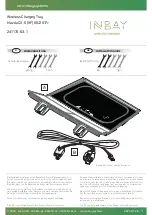
42
IMPORTANT:
Use only authorized refueling stations with adequate pressure controls and venting capacity.
NOTE:
Venting contents of tanks should follow any federal and state guidelines, including EPA.
WARNING: Use only fuel connections designed for use with that on the bus. Do not attempt to force
damaged fittings.
WARNING: Keep sources of heat and ignition away from fuel system and refueling apparatus.
For more information see drawing #1589001 in the owners information package supplied with the vehicle.
COMPRESSED NATURAL GAS FUEL
The performance and reliability of a Natural Gas Vehicle is dependent upon the quality of fuel used. BTU
content of natural gas can vary depending on locale. Excessive moisture can cause driveability problems,
loss of power and regulator freezing. Other contaminants, specifically lubricants and oil, can cause serious
damage which is not covered by the engine manufacturer's warranty. In addition, poor quality fuel can affect
emission certification.
CAUTION: It is the owner's/operator's responsibility to ensure that clean, quality fuel is used to prevent
damage to the fuel system components and power plant. Damage caused by poor quality fuel is not
covered by Blue Bird warranty.
Fuel control systems used on engines fueled by compressed natural gas contain electronic sensors and
other delicate components which are not tolerant to contaminants. Vehicle performance is dependent upon
clean fuel and regular scheduled vehicle maintenance.
Compressed natural gas is expected to be delivered from the compressor station and storage cascade free
of contaminants including oil, water, and particulates.
Conditions exist in some CNG fill stations that cause inferior fuel to be loaded in the vehicles fuel storage
system.
The driving range of a natural gas vehicle is dependent upon driver, fuel BTU content, vehicle weight,
gear ratio, tire size, terrain, engine tune and condition, frequency of starts and stops, full load of fuel and
other factors.
COMPRESSED NATURAL GAS FILTERS
Particulate and coalescer type filters are installed in Blue Bird CNG fuel systems. The primary filter is of
stainless steel construction and is located at the fill point. This filter can be checked for contamination by
closing main shutoff valve on frame and then relieving pressure which is trapped between the check valve in
the fill nozzle and the main system check valve. The owner/operator should establish a service interval
based on quality of gas from the compressor station. It is recommended that the filter sump be checked after
the initial fill and several fills after and then develop a schedule based on need; every fill or every fifth fill or
longer.
The secondary filter has a black anodized housing and is adjacent to the fuel shutoff solenoid close to the
engine. The secondary filter can be checked after relieving system pressure. This is best accomplished by
closing the main shutoff on frame and running engine until fuel supply is depleted and pressure is zero.
Contamination of the secondary filter should not occur if a proper maintenance schedule has been followed
at the fill point primary filter. Contamination of the secondary filter also shows that CNG storage cylinders
on the vehicle are contaminated. The owner/operator should insist that fuel from a compressor station should
be clean and dry.
Replacement filter elements are available through the Blue Bird Service Department.
WARNING: Natural gas is extremely flammable and high pressure gas can cause personal injury, loss of
sight, or death.
















































